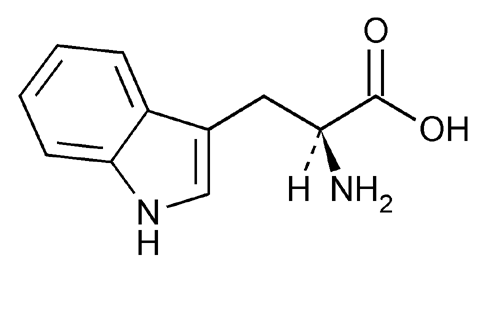Tryptophan
» Tryptophan contains not less than 98.5 percent and not more than 101.5 percent of C11H12N2O2, as l-tryptophan, calculated on the dried basis.
Packaging and storage—
Preserve in well-closed containers.
Specific rotation  781S
781S :
between
:
between  29.4
29.4 and
and  32.8
32.8 .
.
Test solution:
10 mg per mL, in water (heat gently to dissolve, if necessary).
pH  791
791 :
between 5.5 and 7.0, in a solution (1 in 100).
:
between 5.5 and 7.0, in a solution (1 in 100).
Loss on drying  731
731 —
Dry it at 105
—
Dry it at 105 for 3 hours: it loses not more than 0.3% of its weight.
for 3 hours: it loses not more than 0.3% of its weight.
Residue on ignition  281
281 :
not more than 0.1%.
:
not more than 0.1%.
Chloride  221
221 —
A 0.73-g portion shows no more chloride than corresponds to 0.50 mL of 0.020 N hydrochloric acid (0.05%). [note—Gently heat the sample preparation to dissolve, if necessary.]
—
A 0.73-g portion shows no more chloride than corresponds to 0.50 mL of 0.020 N hydrochloric acid (0.05%). [note—Gently heat the sample preparation to dissolve, if necessary.]
Sulfate  221
221 —
A 0.33-g portion shows no more sulfate than corresponds to 0.10 mL of 0.020 N sulfuric acid (0.03%). [note—Gently heat the sample preparation to dissolve, if necessary.]
—
A 0.33-g portion shows no more sulfate than corresponds to 0.10 mL of 0.020 N sulfuric acid (0.03%). [note—Gently heat the sample preparation to dissolve, if necessary.]
Iron  241
241 :
0.003%.
:
0.003%.
Heavy metals, Method II  231
231 :
0.0015%.
:
0.0015%.
Assay—
Transfer about 200 mg of Tryptophan, accurately weighed, to a 125-mL flask, dissolve in a mixture of 3 mL of formic acid and 50 mL of glacial acetic acid, and titrate with 0.1 N perchloric acid VS, determining the endpoint potentiometrically. Perform a blank determination, and make any necessary correction. Each mL of 0.1 N perchloric acid is equivalent to 20.42 mg of C11H12N2O2.
Auxiliary Information—
Please check for your question in the FAQs before contacting USP.
Chromatographic Column—
| Topic/Question | Contact | Expert Committee |
| Monograph | Curtis Phinney
1-301-816-8540 |
(DSN05) Dietary Supplements - Non-Botanicals |
| Reference Standards | Lili Wang, Technical Services Scientist 1-301-816-8129 RSTech@usp.org |
USP32–NF27 Page 3824
Pharmacopeial Forum: Volume No. 33(6) Page 1214
Chromatographic columns text is not derived from, and not part of, USP 32 or NF 27.
